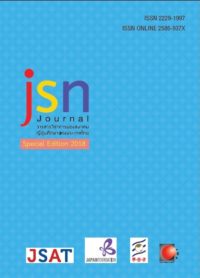The Image of Priest Doumyo Ajari in Ujishuui Monogatari
Main Article Content
Abstract
position to inherit Buddhism’s doctrines to look at Buddhism’s concepts of saving mankind from sin. The positive image of mankind and as members of society could make mistakes in a lifetime as usual behaviour
in Heian Era. For research methodology and data analysis, the researcher studies the content of the tale of
Ujishuui Monogatari and the same character in another tale of Konjaku Monongatari and summary descriptive analysis. The results indicated into two concepts:
1. The image of the priest Doumyo ajari, who acted against the Buddhism’s doctrines by sleeping with a lady without doing any cleansing body rites. This turned into the way of saving mankind from sin as Dousojin, the lower God, came to listen and admired his prayers. This made him into having a positive image.
2. The Image of the Buddhism’s priests who act against the doctrines and do not follow their roles and duties in the social norms. In the case of the priest Doumyo ajari who was a Buddhism’s priest who should have acted and followed Buddhism’s doctrines and social norms strictly. He had been told by the elder priest to be strict with the regulations while performing prayers but he also did not listen. This eventually ended up with the negative image of being the priest at the end of the tale.
Article Details
ข้อความและข้อคิดเห็นต่างๆ ในบทความเป็นของผู้เขียนบทความนั้นๆ ไม่ใช่ความเห็นของกองบรรณาธิการหรือของวารสาร jsn Journal
References
ทวีวัฒน์ ปุณฑริกวิวัฒน์. (2545). ศาสนาและปรัชญาในจีน ทิเบต และญี่ปุ่น. กรุงเทพฯ: สุขภาพใจ.
ประทุม อังกูรโรหิต (2553). พระมหาปณิธานของพระโพธิสัตว์: -ข้อโต้แย้งทางปรัชญาของฌินรัน. กรุงเทพฯ: สำนักพิมพ์แห่งจุฬาลงกรณ์มหาวิทยาลัย.
สุมาลี มหาณรงค์ชัย. (2550). พุทธศาสนามหายาน. กรุงเทพฯ: ศยาม.
อรรถยา สุวรรณระดา. (2558) ประวัติวรรณคดีญี่ปุ่น. กรุงเทพฯ: สำนักพิมพ์แห่งจุฬาลงกรณ์มหาวิทยาลัย.
今井淨圓、廣瀬良弘、村越英裕、望月真澄.(2013).『知っておきたい仏像と仏教』東京:宝島社.
大島健彦.(1985).『宇治拾遺物語』東京:新潮社.
川端善明.(1978).『鬼と仏と人間の小さな物語』東京:平凡社.
小島考乏.(2014).「説話を読み解く : 宇治拾遺物語の戦略」『成城国文学論集』36:12.
小林保治、増古和子. (2013).『宇治拾遺物語』東京:小学館.
佐藤まなみ.(2012).「宇治拾遺物語」における仏教否定定めるの思考―第一0四話猟師、仏ヲ射事」『立正大学大学院国文学専攻院生会』12:11-12.
増田秀光. (2005).『仏教人物の事典:高僧.名僧風狂の聖たち』大日本印刷株式会社.
馬淵和夫、国東文麿、今野達.(1971).『今昔物語』東京:小学館.
『古本説話集 』好色 第十一Retrieved from https://detail.chiebukuro.yahoo.co.jp/qa/question_detail/q10110451785


